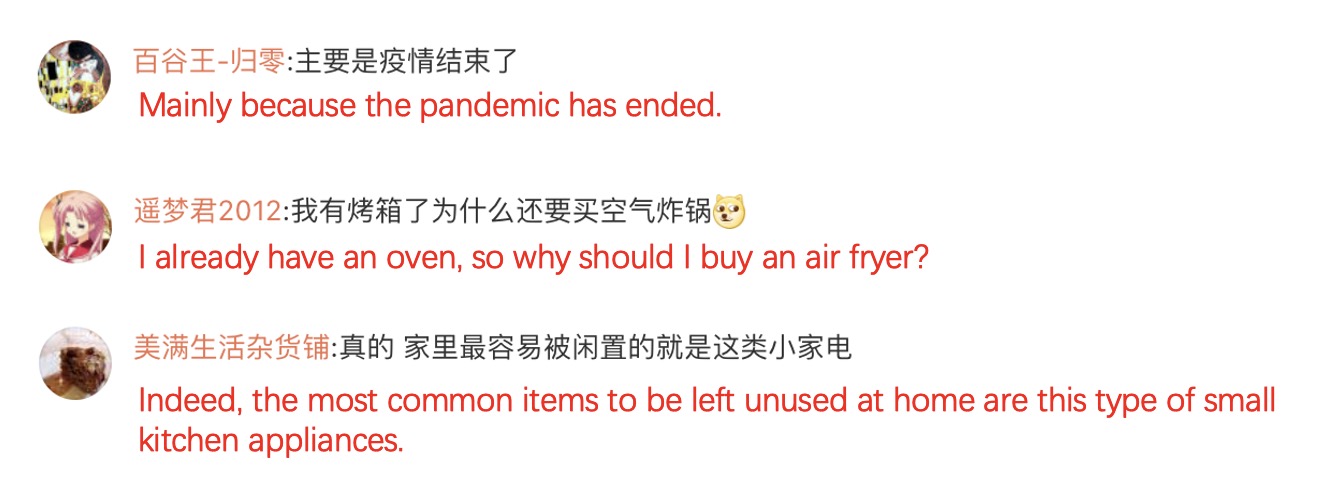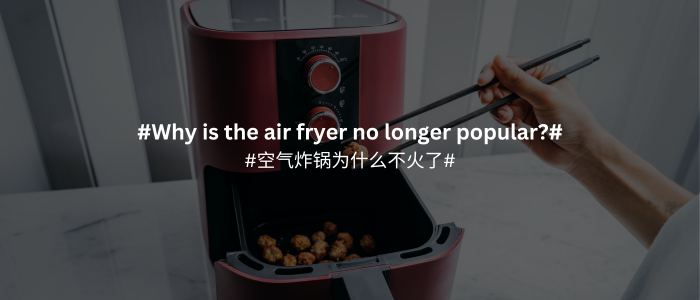After experiencing three years of rapid growth, air fryer sales in China saw a significant decline in the first half of 2023. Online channel sales revenue dropped by 50.59% and sales volume declined by 44.76%. In turn, it led to a decrease in the average product price by 31 RMB. This sudden disinterest in air fryers among Chinese consumers has recently sparked heated conversations on Chinese social media. In the last week of September, the hashtag #Why is the air fryer no longer popular# (空气炸锅为什么不火了). It received over 320 million views, topping the “Hot topics” chart on Weibo.
Download the full report on the She economy in China!

Post-pandemic kitchen trends: declining demand for kitchen appliances
For one thing, the popularity of air fryers has increased during the boom of the “lazy economy” (懒人经济), emphasizing convenience and time-saving. The COVID-19 pandemic has further accelerated this trend, resulting in increased demand for kitchen appliances. However, with the transition into a post-pandemic era earlier this year, people are spending less time at home. Consequently, the lifestyle changes reduced the demand for kitchen appliances. Additionally, some individuals who had previously purchased air fryers now perceive them as high maintenance or even “鸡肋” (of limited value or utility, though not entirely useless), which defeats the purpose of streamlining tasks and simplifying their day-to-day life with such a product.
Reconsidering the need for a new air fryer
The replacement cycle for small home appliances is typically 5-7 years. However, a substantial number of households in China have already acquired air fryers, contributing to market saturation as a potential factor as well. “I think the air fryer is quite useful, but it wouldn’t make sense for me to buy another one since I already have one,” a netizen commented.

Anticipating market saturation’s ripple effects on small kitchen appliances
Potential implications loom over the small kitchen appliances market in China. The saturation witnessed within the air fryer segment could potentially be witnessed in other areas. In turn, it will spark intensified competition among manufacturers for a slice of the market pie. To thrive in this environment, businesses might need to prioritize product differentiation and innovation to maintain their competitive edge. Additionally, the market’s sensitivity to trends, as demonstrated by the fad of air fryer popularity, signifies the need for adaptability and a keen awareness of evolving consumer preferences. This suggests that the success of small kitchen appliance sales may hinge on a business’s ability to swiftly respond to shifting trends and societal fads.
Decline in air fryer demand and changing consumer perceptions
- Air fryer sales in China experienced a sharp decline in the first half of 2023, with online sales revenue dropping by over 50% and sales volume decreasing by nearly 45%, leading to a drop in the average product price. This decline has sparked significant discussion on Chinese social media.
- The decline in air fryer popularity can be attributed to shifting post-pandemic kitchen trends. The “lazy economy” and increased time spent at home during the COVID-19 pandemic had boosted demand for kitchen appliances like air fryers. However, as people spend less time at home in the post-pandemic era, the demand for kitchen appliances has decreased. Some consumers also view air fryers as high maintenance or of limited utility.
- Market saturation is a looming concern in the small kitchen appliances market in China, with the potential for the saturation witnessed in the air fryer segment to affect other areas. This saturation is expected to intensify competition among manufacturers, necessitating a focus on product differentiation, innovation, adaptability, and awareness of evolving consumer preferences to maintain competitiveness in the market.





